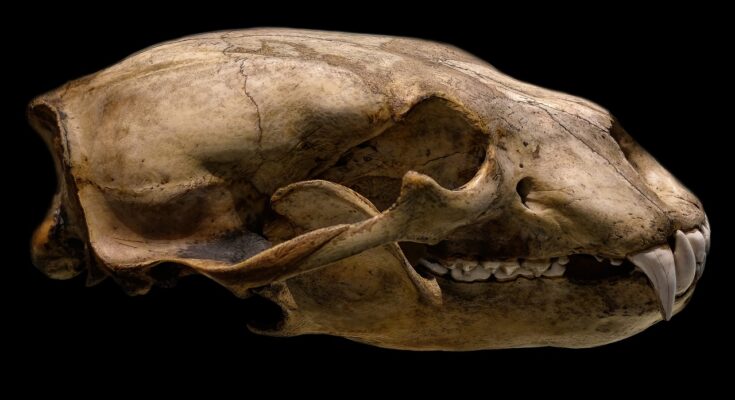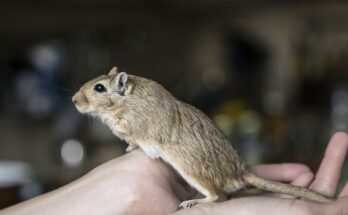Introduction:
Bears, charismatic and powerful creatures, have captured the imagination of humans for centuries. Beyond their imposing presence, the bear skull stands as a testament to the intricacies of nature’s design. In this exploration, we embark on a journey to unravel the mysteries concealed within the bear skull, examining its unique features, evolutionary adaptations, and the crucial role it plays in the life of these formidable animals.
The Basics of Bear Anatomy:
The skull serves as a fundamental structure that defines the identity of a species. In bears, the skull is no exception, reflecting their evolutionary journey and adaptation to diverse environments. Bears belong to the family Ursidae and are known for their distinct morphological characteristics, with the skull being a central component of their anatomy.
Cranial Adaptations:
One of the striking features of a bear skull is its robust and powerful nature. The skull is designed to support the massive muscles required for powerful jaw movements. The pronounced sagittal crest, a bony ridge along the top of the skull, serves as an anchor for the temporalis muscle, which powers the bear’s strong bite. This adaptation is particularly prominent in species like the grizzly bear, highlighting the connection between form and function in the evolution of the bear skull.
Dentition:
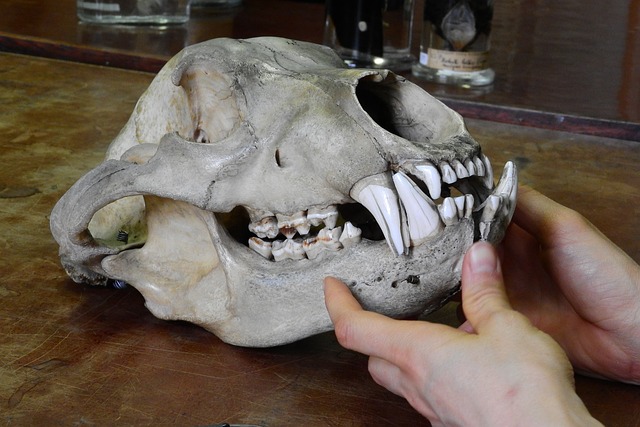
The dentition of bears provides valuable insights into their dietary habits and ecological roles. Bears are omnivores, and their teeth are adapted to a mixed diet of plant material, insects, and, in some cases, large mammals. The dental formula of bears includes powerful premolars and molars for crushing and grinding, as well as sharp canine teeth for hunting and tearing. Examining the wear patterns on bear teeth can reveal details about their feeding behaviors and the ecological niches they occupy.
Species Variability:
While all bear skulls share fundamental characteristics, there are notable variations among different species. The skull of a polar bear, adapted for life in the Arctic, differs from that of a panda, which has evolved to consume bamboo. These variations in skull morphology reflect the unique ecological niches each species inhabits and the specific challenges they face in their respective environments.
Cultural and Symbolic Significance:
Beyond its biological functions, the bear skull holds cultural and symbolic significance in various societies. Throughout history, bears have been revered and feared, and their skulls have been incorporated into rituals, ceremonies, and art. In some indigenous cultures, the bear is considered a powerful spirit animal, and its skull may symbolize strength, courage, or a connection to the natural world.
Paleontological Insights:
Examining fossilized bear skulls provides paleontologists with valuable information about the evolutionary history of bears. Fossilized skulls allow scientists to trace the development of different bear species over millions of years, offering a glimpse into the adaptations that enabled these creatures to survive and thrive in changing environments. The study of bear skulls contributes to our broader understanding of mammalian evolution and the interconnectedness of life on Earth.
Conservation and Anthropogenic Impacts:
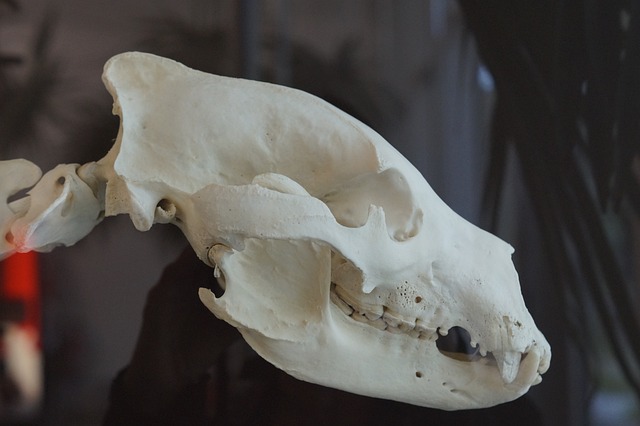
As with many species, bears face numerous threats from human activities, including habitat loss, climate change, and poaching. The bear skull becomes a poignant symbol of the challenges these animals endure. Conservation efforts aimed at protecting bear populations and their habitats are crucial for ensuring the continued existence of these iconic creatures and the preservation of the intricate beauty of their skulls.
Evolutionary Adaptations in Bear Skulls:
The evolutionary journey of bear skulls spans millions of years, revealing a series of adaptations that have allowed these creatures to thrive in diverse environments. Fossil records provide evidence of the gradual changes in bear skull morphology, highlighting the species’ ability to adapt to varying ecological conditions. The bear skull’s evolution showcases nature’s ingenuity, as these animals have successfully navigated the challenges posed by different habitats, climates, and available food sources.
The emergence of distinct species within the Ursidae family has resulted in a variety of skull adaptations. The polar bear, for instance, has a more elongated skull compared to other bears, reflecting its specialization for hunting marine mammals in the Arctic. In contrast, the short-faced bear, an extinct species from the Pleistocene epoch, exhibited a shorter and more robust skull, possibly adapting to a predatory lifestyle.
Cranial Features and Behavioral Insights:
Beyond its physical structure, the bear skull provides clues about the behavior and lifestyle of these creatures. The size and robustness of the skull correlate with a bear’s dietary preferences and hunting strategies. Grizzly bears, known for their powerful bite, have a well-developed sagittal crest, indicating a reliance on crushing tough vegetation, digging for roots, and preying on large mammals.
The bear skull also sheds light on the animal’s social structure. Variations in skull size and shape among individuals within a population may be linked to factors such as age, sex, and social hierarchy. Studying bear skulls allows researchers to better understand the complex social dynamics within bear populations, providing valuable insights for wildlife management and conservation efforts.
Hypercarnivory and Its Impact:
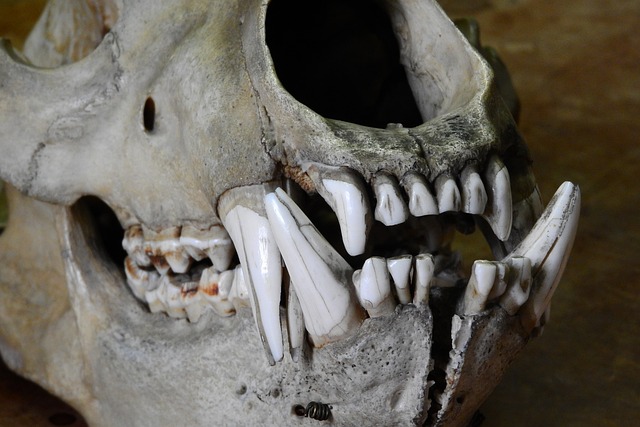
While most bears are omnivores, capable of subsisting on a varied diet, some species, like the polar bear, are considered hypercarnivores. The polar bear’s skull is adapted for a diet primarily composed of seals and other marine mammals. The elongated shape facilitates a more efficient bite, essential for capturing and consuming prey in the Arctic environment. Understanding the adaptations of hypercarnivorous bears is crucial in assessing the potential impacts of climate change on their ecosystems and prey availability.
Skull Biomechanics and Feeding Strategies:
The biomechanics of the bear skull play a pivotal role in its feeding strategies. The specialized dentition allows bears to exploit a wide range of food sources, from tough vegetation to animal flesh. The powerful jaws and teeth contribute to their ability to process diverse food items efficiently. By studying the mechanics of the bear skull, researchers gain insights into the foraging behaviors and dietary preferences that have enabled bears to occupy a variety of ecological niches.
Conclusion:
In conclusion, the bear skull is a marvel of evolution, blending form and function in a way that reflects the unique characteristics and adaptations of these magnificent animals. From the robust cranial features to the specialized dentition, the bear skull tells a story of survival, ecological adaptation, and cultural significance. As we delve into the intricacies of the bear skull, we gain a deeper appreciation for the natural world and the importance of conservation efforts to protect these awe-inspiring creatures and their remarkable anatomy. Read more
FAQS:
A bear’s skull will be robust and powerful, characterized by an overall broad and rounded shape with a prominent sagittal crest. The orbits (eye sockets), will be large and round, and positioned facing forward. The nasal aperture is large and rectangular in appearance, aiding the bear in an excellent sense of smell.
For bear, you would want at least a 10mm and at least Glock 20 length barrel with full power ammo, if not a 12ga shotgun. Yes, your. 40 will penetrate the skull of a bear. The problem is hitting it and hitting the right spot.
Most commonly bear symbolizes courage, trust, endurance, resistance, strength, protection, spirituality, and deep connection with nature.
A frontal hit directly into the eye will not enter the brain, but be deflected and travel along the skull.. The plate between the eyes has a slope of about 30 degrees and would greatly aid in deflecting a pistol bullet. It’s easy to see why a bear is tough to kill with a pistol.
The weakest part of a bear’s skull is behind the face, in a small triangular shaped area roughly bounded by the eyes and the tip of the nose. A bullet striking this area has the greatest chance of penetrating the skull, hitting the brain and stopping the attack immediately.
It is likely that the skull would be crushed if a bear were to step on a male human’s head using its full force. However, it is important to note that bears are wild animals and should not be approached or provoked.

